Periradicular, periapical or apical periodontitis can be defined as inflammation of all the supporting structures of the teeth in the area surrounding the apex of the tooth. Periapical inflammation is usually due to tooth infection which characteristically causes pain of tooth in its socket. It is often accompanied by destruction of bone and occasionally, the root apex of tooth. However the periapical tissue has the ability to heal if the cause of inflammation is removed. Periapical periodontitis can be divided into acute and chronic apical periodontitis.
Causes of apical periodontitis
- Infection – by far the most common cause, bacteria causes decay of tooth which leads to pulp inflammation (pulpitis) and death of the pulp (the soft inner part of the tooth). If pulpitis is not treated; bacteria, bacterial toxins or products of inflammation can extent down the root canal and cause periodontitis.
- Trauma – any direct blow to the tooth can sometimes cause the pulp of the tooth to die and it may become infected by bacteria from the gum margins, leading to apical periodontitis. A sudden bite on a hard object, undue pressure during orthodontic treatment or a filling that is high can sometimes cause acute periodontitis though usually short-lived.
- Root canal treatment – mechanical instrumentation through the tooth root during treatment or chemical irritation from root-filling materials may result in inflammation of the periapical region.
Acute apical periodontitis
Signs and symptoms of acute apical periodontitis
- The affected tooth is often having a large decay area, a filling or may be discolored due to a dead pulp in the tooth.
- The gum over the root of the affected tooth is red and sore.
- May be associated with swelling of the face for infection can penetrate the overlying bone or soft tissues.
- Sometimes connected with fever or body discomfort.
- Pain associated with the disease:
- Is spontaneous in onset with a moderate to severe intensity in pain and usually persists for long periods of time (hours).
- Is more intense and throbbing if inflammation becomes more severe and pus starts to form.
- Can be pinpointed to the affected tooth.
- Is aggravated by biting of teeth. In some cases, the tooth feels “high†or like it is coming out and is very sensitive to touch.
- Has often been followed by pain in the pulp and usually associated with a dead tooth.
- Hot or cold substances do not cause pain unless in multirooted teeth whereby some pulp tissue remains healthy.
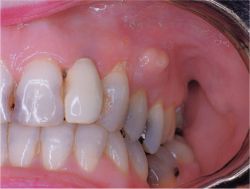
Periodontal abscess © The Free Dictionary

Periodontal abscess © The Free Dictionary
Possible complications of acute apical periodontitis
- Pus or abscess formation
- Swelling of the lymph nodes on the face or neck
- Spread of the infection to other areas
Treatment of acute apical periodontitis
- Extraction of the diseased tooth – this is the simplest and most effective method as it removes the source of infection and drains the pus.
- Root canal treatment – the root can be retained by root canal treatment, which can also be used to drain the infection.
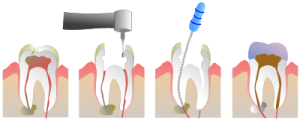
Root canal procedure
Chronic apical periodontitis
Chronic apical periodontitis is a low-grade infection usually following an acute infection that has not completely healed or was inadequately treated.
Signs and symptoms of chronic apical periodontitis
- The involved tooth is normally dead
- Sometimes symptoms may be minimal or none at all.
- Pain associated with the disease:
- Is slightly painful on tapping of the affected tooth.
- Is mild on biting or chewing.
- The tooth feels “high†or like it is coming out and is very sensitive to touch
Possible complications of chronic apical periodontitis
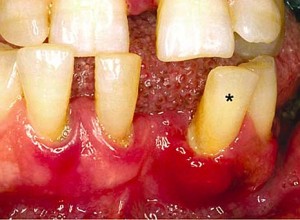
Radicular cyst © flipper.diff.org
- Growth formation in the periapical region (periapical granuloma)
- Cyst formation in the apex of the affected tooth (radicular cyst)
- Pus formation and abnormal opening from the mouth to the outer face (sinus)
- Acute worsening of the disease
Treatment of chronic apical periodontitis
Similar to acute apical periodontitis, extraction or root canal treatment are the main options. Persistence of chronic periodontitis after root canal treatment is usually due to technical faults during the procedure and removal of the apex of the tooth may be advised.
Prevention of apical periodontitis

© Extraordinary Uses Blog
- Home remedy for periodontitis is to practice good oral hygiene with proper tooth brushing techniques and the usage of floss and mouthwash. You can also make your own mouthwash to reduce infections in the mouth.
- Make regular appointments with your dentist to ensure your mouth stays in a healthy condition
- Avoid injury or a direct blow to the teeth or gums.
- Avoid biting too hard while eating.
- If you feel any pain in a root canal treated tooth, go back to your attending dentist to find out the cause of the pain and rectify it.
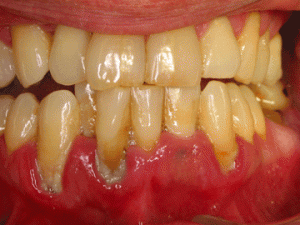
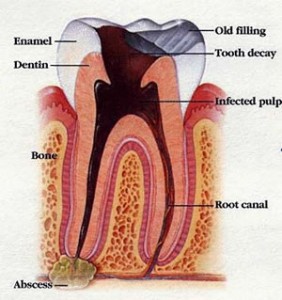
Pingback: Causes of Gum Swellings and Lumps Part1 | Intelligent Dental
Pingback: Causes of Red, White or Pigmented Gums | Intelligent Dental
Pingback: How do you know if toothache is caused by sinus infection? | Intelligent Dental
Pingback: Dental Assistant Guide to Root Canal Treatment | Intelligent Dental
Pingback: Chronic Adult Periodontitis: Cause and Symptoms | Intelligent Dental